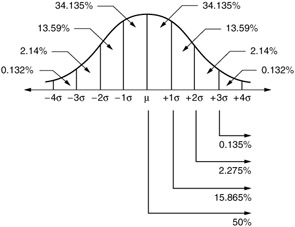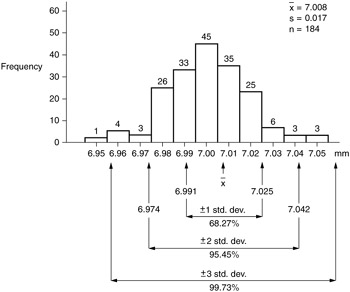CHARACTERISTICS OF THE NORMAL DISTRIBUTION
The normal distribution can be described entirely by its mean and standard deviation. It has the following characteristics (see Figure 5.2):
-
The point of greatest frequency is at the mean ( ¼ ). The mean of a normal distribution also equals the median and the mode. Figure 5.2 shows one mode, a median that is in the middle of the data, and a mean that is the balance point of the distribution.
-
The distribution has equal curvature around the mean. If the distribution were cut in half, each side would mirror the other. (Although all normal distributions are symmetrical, all symmetrical distributions are not normal in shape.)
-
On both sides of the mean, the curve slopes downward toward infinity. The tails of the curve never touch the horizontal axis. This is very important, and we are going to use this principle when we talk about zero defects. A prelude to that discussion is that there is no such thing as zero defects from a theoretical production point of view. However, zero defects makes sense only from a customer perspective and is solely a definitional zero.

Figure 5.2: Characteristics of the normal curve.
Numerical description can also be made for the normal distribution. If the curve is divided into zones defined by standard deviations, area under the curve (or probability) may be calculated (see Figure 5.3):
-
The mean plus or minus one standard deviation ( ± 1 ƒ ) contains 68.27% of the distribution.
-
The mean plus or minus two standard deviations ( ± 2 ƒ ) contains 95.45% of the distribution.
-
The mean plus or minus three standard deviations ( ± 3 ƒ ) contains 99.73% of the distribution.
-
The mean plus or minus four standard deviations ( ± 4 ƒ ) contains 99.994% of the distribution.

Figure 5.3: Normal distribution divided into zones of percentage.
Although the normal distribution continues beyond four standard deviations, the additional area contained in this part of the curve is very small.
Applying the normal distribution to a manufacturing process is relatively simple. One hundred eighty-four items were measured and summarized with a histogram and descriptive statistics (see Figure 5.4). Because the shape of the sample group is similar to the normal distribution, the following are good estimates for the population:
-
68.27% of the items are estimated between 6.991 and 7.025 mm.
-
95.45% of the items are estimated between 6.974 and 7.042 mm.
-
99.73% of the items are estimated between 6.957 and 7.059 mm.

Figure 5.4: A histogram of 184 items.
It is often necessary to describe values that do not fall on whole-number standard deviations. This case is such an instance. Station No. 19 began locking up one evening. The maintenance team learned that parts on the high side of the distribution were causing jams. A study was conducted , and results showed that any part larger than 7.035 mm jammed in the out-feed tracks. The machine operator for Station No. 9 wanted to know how much of the station's production would be wasted . To answer this question, the process must be described in more detail.
EAN: 2147483647
Pages: 181